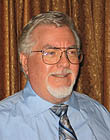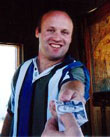|
|
This topic comprises 2 pages: 1 2
|
|
Author
|
Topic: Drive-In Aspect Ratio's - Do They Really Matter?
|
Barry Floyd
Phenomenal Film Handler

Posts: 1079
From: Lebanon, Tennessee, USA
Registered: Mar 2000
|
 posted 12-02-2002 09:16 AM
posted 12-02-2002 09:16 AM





We are getting ready to place the order on our screen towers for the drive-in, and have several different quotes - each for a different size screen or aspect ratio.
I've seen many drive-in screens built with a fixed 2:1 ratio, but I know that crops a scope image a bit. If we had a true 2.39:1 screen ratio, and showed a FLAT image upon it, it would leave a black border about 6 feet on each side of the image but fill the entire height of the screen. The only drawback is that the patrons could see that the image isn't entirely filling the screen, and may percieve that they aren't really getting the "BIG" picture they were expecting.
So the question is: Do we order a 2:1 ration screen and loose (crop) a couple of feet of the image, and totally fill the screen with a FLAT image and loose nothing, OR order a true 2.39:1 ratio screen, and fill it completely with a SCOPE image, and end up with a smaller projected FLAT picture?
There's not really enough difference in price of the towers to justify one over the other?
| IP: Logged
|
|
|
|
|
|
|
|
|
|
Randy Loy
Expert Film Handler

Posts: 156
Registered: Aug 1999
|
 posted 12-02-2002 12:51 PM
posted 12-02-2002 12:51 PM




Barry,
Debrean and I have visted about 270 drive-in theatres and seen films presented at over 80 drive-ins during the past 12 years so we've seen a lot of different screens. Some were built 2.35:1 or 2.39:1 and quite a few were built at a 2:1 ratio. We've even seen a few that were never added to after the advent of CinemaScope and still are "flat" screens even though we've seen scope films shown on them.
In my opinion, the ends of a scope screen when unlit during the projection of a 1.85:1 image is not that noticeable in an outdoor setting. I doubt that most drive-in customers even pay attention to the fact that part of the screen is unused during a flat picture or not masked like many indoor screens are. In fact, now that I'm a projectionist myself I sometimes wonder how I could have missed the fact that favorite non-anamorphic films shown at drive-ins during my youth didn't fill the giant screen edge-to-edge. While it's something I think about now that I have some involvement in the industry, I never paid any attention prior to training in a booth. My guess is that most people would fall into that same category.
Too much cropping is obviously a different story. I've seen a few drive-ins that use focal length lenses that are too short when doing 1.85:1 presentations. This of course results in cropping and I find that to be very noticeable. One drive-in manager explained to us that they did that because they wanted their patrons to enjoy the largest image they could provide, even with a flat picture. While I appreciated his attempt at showmanship, it just didn't work since the cropping was obvious.
This past summer we saw "Spirit: Stallion of the Cimmaron" properly presented at one drive-in and then severely cropped at another. I noticed that the characters' eyes and foreheads kept disappearing off the top of the screen at the second drive-in, something that I think would have been noticeable even if I had not already seen the film properly presented. "Stallion" was followed at the second theatre by "The Sum of All Fears" and the subtitles used when the russians spoke disappeared off the right side of the screen. I have also seen a drive-in that used a flat lens that was too long and it resulted in white screen at the top and bottom as well as on both sides. That made be feel cheated more than having unfilled screen just at the sides. Fortunately, the last time I was there they had swiched to a proper focal length lens.
To get back to your original question, It has been my observation that a 2:1 aspect ratio screen at a drive-in, while not preferrable to a 2.35:1 screen, is usually not too noticeably short for scope pictures as long as the proper focal length lens is used to give the proper height, top to bottom. However, if you can do the 2.35:1 screen, I think that would be the way to go. I wouldn't worry about the unused edges during flat presentations.
| IP: Logged
|
|
|
|
|
|
|
|
|
|
|
|
|
|
|
|
|
|
|
|
|
|
All times are Central (GMT -6:00)
|
This topic comprises 2 pages: 1 2
|
Powered by Infopop Corporation
UBB.classicTM
6.3.1.2
The Film-Tech Forums are designed for various members related to the cinema industry to express their opinions, viewpoints and testimonials on various products, services and events based upon speculation, personal knowledge and factual information through use, therefore all views represented here allow no liability upon the publishers of this web site and the owners of said views assume no liability for any ill will resulting from these postings. The posts made here are for educational as well as entertainment purposes and as such anyone viewing this portion of the website must accept these views as statements of the author of that opinion
and agrees to release the authors from any and all liability.
|

 Home
Home
 Products
Products
 Store
Store
 Forum
Forum
 Warehouse
Warehouse
 Contact Us
Contact Us




 Printer-friendly view of this topic
Printer-friendly view of this topic






![[thumbsup]](graemlins/thumbsup.gif)






![[Smile]](smile.gif)




![[beer]](graemlins/beer.gif)




